-
Posts
1,999 -
Joined
-
Last visited
Content Type
Profiles
Forums
Store
Help Articles
Posts posted by Peter Green
-
-
Surprisingly, the restaurant chain was produced by Mari Natsuki, a singer. She did the voice of Yubaba in that movie, "Sprited Away"!
Is this just a coincidence or did you do this on purpose?
Cool!

Life is a collection of discrete events bobbing about in a sea of coincidence.
-
As with a lot of these, I wish they'd clearly state what they base this on. Is it just the number of "hot" places, or is there another factor involved.
Mind you, I'm tickled that the old home town made the cut, but I'd still wonder about Vancouver, Chicago or Stockholm over Shanghai, Bogota, Melbourne, Bangkok, Singapore or a host of others.
It's interesting that Seiji Yamamoto from Ryugin in Tokyo is seen as one of the top new chefs. That I'd agree with.
-
The Incredible Lightness of Being Krispy
Scud and I got into a discussion recently on when we last ate a donut.
At that time (some two weeks ago) it came out that we hadn't been near a deep fried pastry for well over a year.
Possibly two....or three. It's been awhile.
Our local is Mr. Donut
Why they call something so deeply Freudianly female "Mr." I don't know........
But then I realized that this wasn't the case (the two years, that is). In Korea we'd stopped in at Krispy Kreme to get some of the fresh off the line product.
That's when I got to thinking about it, in line with my nephew Jason's comments.
Is KK really a donut?
As we ate them (tip: if you have old KK in the house, nuke them for 10 seconds, that'll restore them) the impression wasn't so much one of eating a donut per se, but rather of a unique and ethereal bonding of fat molecules with a minimum of mass.
This would explain the greasy after taste that many of the commentors here write of, similar to Paco Rancero's dragon oil (olive oil foam flash frozen in liquid nitrogen) which evaporates as soon as it hits the heat of your mouth, resulting in a plume of oil "steam" out of your nose.
So, is KK really a donut as we know it?
(second tip: drink lots of soju and that bad taste will go away.....but there may be something in its place......)

-
Sorry if I missed it, Chris, but did you mention where all those PB&Js are destined for?

By the way, the grid photos showing the step-by-step preparations are awesome!
Chris, along with the food itself, I'm also really taken with the grid montages. How are you doing these? Are you putting them together into one image, or are you concatenating the images int the post. They're a great format for showing step by steps, and really an outstanding tool for the one week foodblogs!
Cheers!
Peter
-
March 22 – The Magic of Udon
Before the noodles, however, there was some work to be done. We were running short of cash, and it was a weekend. I needed to burn some of my Euro travellers’ checques.
As I’d mentioned, it’s nice to have help. The young fold at the desk made some calls, and found an exchange bank open until 5 p.m. in the Tokyo Midtown complex.

Tokyo Midtown and the nearby Roppongi Hills development, have made a good attempt at upscaling the image of Roppongi. Lots of money; clean, clean designs; the Suntory Museum (of art, unfortunately. I would’ve made time for booze); a major theatre complex; and people not associated with the hostess bar industry (at least some of them).
Scud’s eyes went big. This is what he’d expected from Japan. Okay, the Boy’s led a sheltered life, cloistered on the camp for much of it, but, still, we’ve spent enough time living in Bangkok that he should be used to major mall action.

But this was pretty.
Wood floors, for starters. And money spent on displays that looked good. Space, plenty of it, and light. This wasn’t some concrete shell thrown up with low-bid workers in Dubai or Bahrain. This looked slick.
We did the money thing, and then poked around the restaurants and shops for a bit. There was a good selection of food everywhere, but, I must say, the bias I’d seen towards sweets and desserts went beyond just Rona’s company. It seemed like every second or third shop was a chocolaterie or a patisserie.
Nothing wong with that, though! (I’m waiting for Rona to throw something).
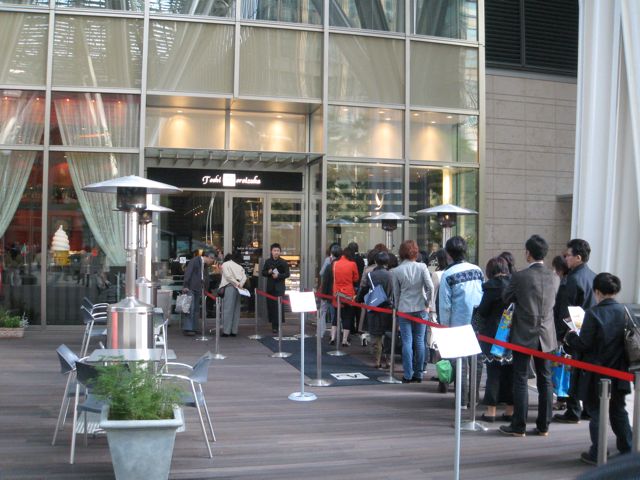
One image that really sticks in my mind, though, is Toshi Yoroizuka’s Salon de Dessert, on the ground floor, facing into the open plaza. It had a queue to get in every time I went by. Conde Nast’s Adam Platt had a piecee on the place
and it’s worth the read, as it goes further to discuss the “food craze” that’s taken over in the last 15 years. He quotes Setsuko Yuuki as stating that Iron Chef was the turning point for foodies in Japan. Now, take that with a grain of rice, as she was involved in the programme. I don’t think the Japanese have stinted on dining for a very long time. But I do recall, back in the late 80’s, the discussion of the Ramen Generation, a slice of Japanese society that had been raised on instant noodles and snack food. At that time the older folks were complaining about kids not even knowing how to make rice anymore (there were cooking shows that concentrated on basics such as rice, and cooking an egg).
And, I also know that the imported Hell’s Kitchen was ruling the tv roost in Korea when we were there last year, with everyone watching the show. (On the East Coast, at lunch, we heard one of the ajimas give a perfect “yes, chef” response when questioned on something. The cook didn’t swear as much as Ramsay, though).
Back to Yoroizuka’s Salon de Dessert - I’ve read that his pistachio tarte is a thing of wonder, but, given my disinclination to wait in lines, I may just continue to wonder.
I was also struck by the A971 Café, fronting the complex, that had a sign up stating that patrons needed to stay within the bounds of the red ribbon. Suddenly I was having flashbacks to Battle Royale’s unique counselling methods for disruptive teens (a great Beat Takeshi film, and a must see for the lady that explains the rules).
Across the street from Midtown was a yakitori place that had come recommended. I figured we could give this a try. Unfortunately, a lot of the places in Roppongi don’t seem to do lunch, but only cme alive in the evening. We found this out after we were stuck in an elevator that was turned off.
So, we headed down across the crossing.

(Scud showed a certain appreciation for the decor of the neighborhood, but he was chomping at the bit to get to Akibahara)
I had a back up plan for food.
Tsurutontan, the udon people.
Our family is very fond of udon. Serena, in particular, can go through three or four bowls’ full in one sitting at the small Japanese place down the street from our sister’s place on Vancouver.
People always seem happier to oblige her than the rest of us……
Anyways, all of us are well disposed to this oldest and most basic of noodles. Flour, salt, and water. What could be simpler? The Korean variant of this – kalguksu – adds egg to the mix, but I’ll chicken out of making odd yolks on the matter.
(sorry, I couldn’t help myself)
Actually, there’s a question. Are Japanese udon also “knife cut”? (I’m ignorant, I freely admit it.)
This shop seems out of place on the main drag in Roppongi. For one, it’s a large store front. For another, it’s clean, slick, and good looking (more on the main drag of Roppongi later).
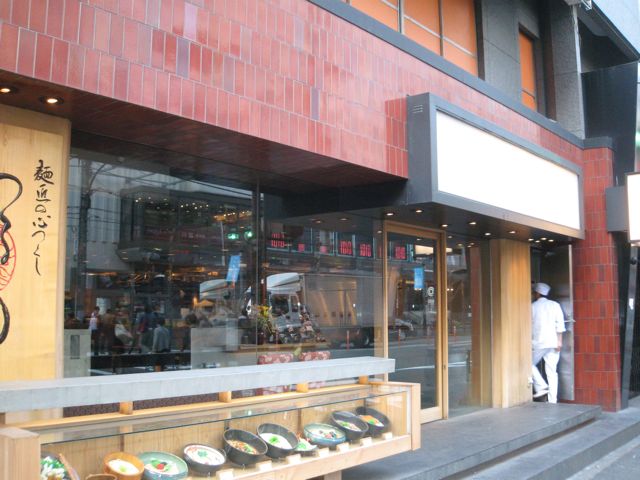
This was an easy sell for Scud and I.
Inside we were shown to booth seating, and then our waiter ran off to find their English menus. These were clearly printed, and explained the Mission of Tsurutontan – to bring people to a better appreciation of udon.
Amen to that, say the Greens.
I believe the chain (and this is one of several udon outposts in this brave new world) came from Osaka (big cheer for Osaka, everyone), which means that you might expect them to push Kansai preferences.
But their selection is wide, and meant to encompass and embrace a myriad of possibilities – even if you’re a fox (with sweet tofu) or a tanuki (topped with deep fried tempura batter)

There selections range from simple bowls of udon (but what bowls! The noodels come out in large wooden buckets in some cases, in huge bowls with wooden lids in others) and in nabes of udon, huge steaming hot pots with selections of other ingredients to go in. I watched intently as my neighbor received a large bucket with chilled udon noodles inside, which she dipped into an acccompanying sauce.
They also have sake, of course, but push a selection of jizake, which they describe as “local brand sake”. This, I take it, is a reference to small batch brews, but how this fits in with the Japanese limitations on licensing of breweries isn’t a question I can answer right now.

My choice was a Fukui prefecture sake – Kokuryu “genuine brewing” – served in a solid, rugged bit of pottery, with a tortured lip that did a good job of spilling out the aroma. A pleasant sake, with a tang once I spilled some into my mouth.
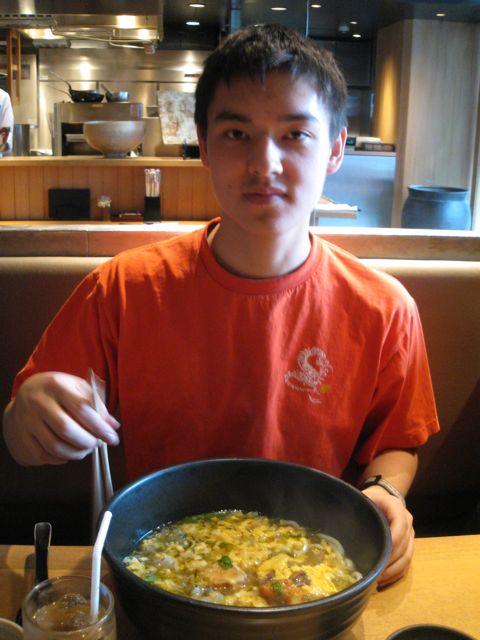
Scud’s attention was taken by the clam and fried tofu udon. This came with a hot and sour broth incorporating apple vinegar. Scud didn’t pay any attention to the hot and sour part, though, and focused on the shellfish issue.

This failure in details, unfortunately, resulted in an udon that wasn’t quite to his tastes, the vinegar flavour almost taking away from the simple goodness of soft, thick udon.

Almost.
I was torn by my choices. In particular I liked the idea of a kelp udon (rishiri, it said), but then my carnivorous eyes lit upon something……
Shabuniku curry udon, with Tokusen wagyu beef.
After the Houston wagyu thing, I had to do this. Wagyu and curry!
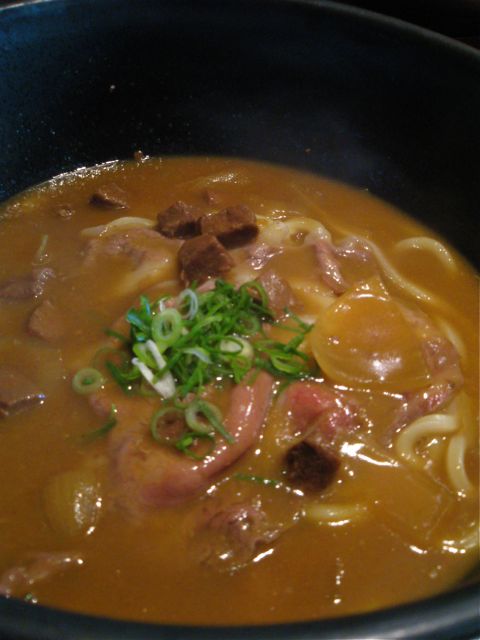
Oh, these noodles were so soft and slurpable. Which, of course, just leads to getting curry sauce all over the place.
Heck, these people are never going to see me again, right? Who cares if I have curry sauce in my beard?
Our dish also came with one of my favourite Cairo treats – inarizushi. Sweet and filling. In Egypt, back in the 80’s, you could get basically nothing. Heck, we even did trips to Istanbul to buy flour and sugar. There was Okamoto’s over in Mohandessin, and Tokyo Kitchen in Zamalek (which I fondly remember for its pile of manga by the door), but these places knew their limitations, and stuck to hot pots and stews and tonkatsu. The rice available was, well, challenged, and so they didn’t mess about with rice dishes.
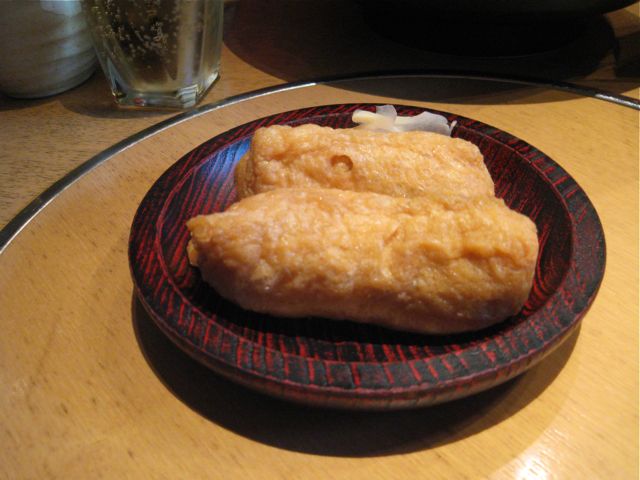
So, Yoonhi being the intelligent young thing she is (or was…ouch!) would bring back cans of inari to make inarizushi, the sweetness of the inari covering over the harsh reality of Egyptian rice. Sometimes she’d even get ahold of good rice (although that was a rare occurrence).
I’m digressing again, aren’t I?
Anyways, these were a welcome treat. I was tempted not to share with my Philistine son, but it did occur to me that they probably came with his meal.
I was very comfortable with this place. Perhaps it would be worth coming back, as convenient to our nest as it was?
Maybe I should clean up some of this curry sauce in my beard first?
Note: edited to fix the Conde Nast link.
-
Nice to know that some things are no different worldwide. Loving your blog.....
BTW, how old is Scud?
Ah, the Boy is at the ripe old age of 16 and a half. Too old for cleaning out chimneys, too young for the corporate ladder.
And, contrary to his dreams, neither Sony nor Konami are beating a path to his door to hire him as a game tester.
Patience, patience......
-
March 22 – Go East, Young Man
Morning. Our last in Kyoto. We rose late, policed the apartment, discovered a packet of Pocky that had escaped the Boy’s attention, devoured that, packed our hand carry (our big bags had been sent ahead through the good graces of 7-11 and the Black Cats), said good bye to our Canadian neighbors next door, locked up, unlocked, sent the boy back inside to double check I hadn’t forgotten anything, then relocked, put the key in the key box, and left the building.
It was a pleasant morning, what was left of it, being close to 10 a.m. We walked across the river, and made for Kyoto Station. I suppose we could have done more sightseeing, but the time seemed right to leave. An early departure would place us in Tokyo that much the sooner.
Buying the tickets was, again, a straightforward affair. A brief interrogation at the counter, and then Scud and I were free to admire the clerk’s handwork, his fingers flying across the touch screen, establishing our reservations with a speed that would almost indicate that he played way too many video games as a youth.
It was quite something to watch, reminding me of the cyborg’s hands in Ghost In The Shell, which would disengage and extend to dash over the keyboards like mechanical spiders. But then, why would cyborgs interface through a keyboard when they could simply patch in and converse in machine language?
The boy and I spend a lot of time arguing these points.

Blue skies and bullet trains. It was a fine day to be heading East for Tokyo. I tried to engage the boy in the countryside outside our window, but, true to form, he plugged into his iPod and dozed off within minutes.
Myself, I used the time and my remaining battery life to catch up on my writing (I did try!)
Mt. Fuji appeared on our left, and I woke the boy up for the view. It was crystal clear, it’s slopes rising up to a crown of snow. He just grunted, and went back to sleep. And then, in a fortunate bit of timing, some death metal came onto the ‘Pod at about four times the previous volume.
It was quite entertaining watching him thrash about for the few seconds it took for him to find the volume control.
My mirth didn’t appear to be contagious.
Alighting at Tokyo Station, we took the underground to Ginza, and from there to our new home for the week.

Roppongi. The six trees.
Legend has it that the area took it’s name from six daimyo that lived in this area during the Edo period, all of whom had the character for “tree” in their names. That’s the legend.
What Roppongi is now is pretty much party central for the foreign population. In the past several US military installations were sited near here, with the concommitant camp followers you would expect (and all of the negative impact that goes with that).
However, it, along with Azuba, just down the hill, is also a fairly solid concentration of restaurants.
But more on Roppongi later. However, for a good read on the post war years that shaped the area, I’d recommend Robert Whiting’s Tokyo Underworld, which concentrates on Nick Zappetti, the “King of Roppongi”, and the yakuza interweavings that went on. For a fictional version, Christopher Moore (best known for his Thai work) has also written Tokyo Joe, which loosely (very loosely) uses Roppongi as a backdrop.
We crawled out from the subsurface to the light of mid afternoon, and a march.

I feel you should – with some discernment – give consideration to what you find placed in front of you. I placed the bags in the care of the Boy, broke out the video camera, and shot some of the event; a pro-Tibet protest
And someone had the nerve to ask me for my press credentials!
It struck me then how isolated we’d been. I really had no idea of what was happening in the world.
I kind of like it that way, for awhile.
Once the riot police had closed up shop behind the march (which did go on for some time), we continued down the hill in the direction of Asakasa and our new home.
I’d decided that Tokyo was best enjoyed with some level of comfort. We were staying at Oakwood Apartments, a serviced apartment, which meant that we’d have the benefit of a front desk for help with reservations if we should need it.
It also meant a certain degree more space, something Scud and I were looking forward to.
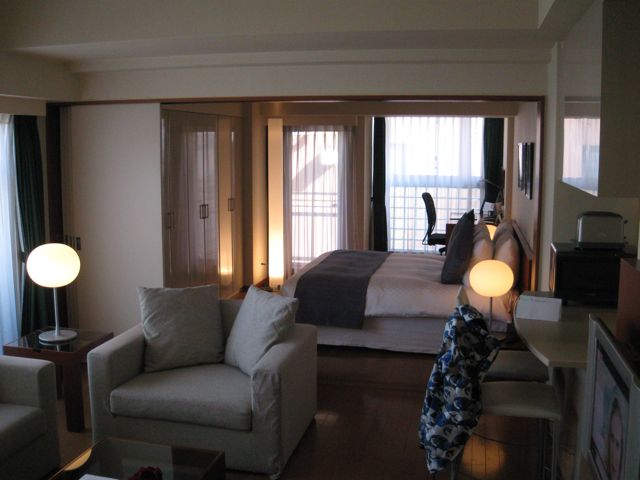
To say I was happy with the digs would be an understatement. True, the boy had to go back on the floor with a futon, but that was his problem, not mine. (“How come you get the bed?” “How come you don’t pay for anything?”)
Our position was fine, with a view from the balcony looking out over past the graveyard just to our right. Tokyo Tower loomed over our skyline. If Godzilla was to attack, we’d have a great view.
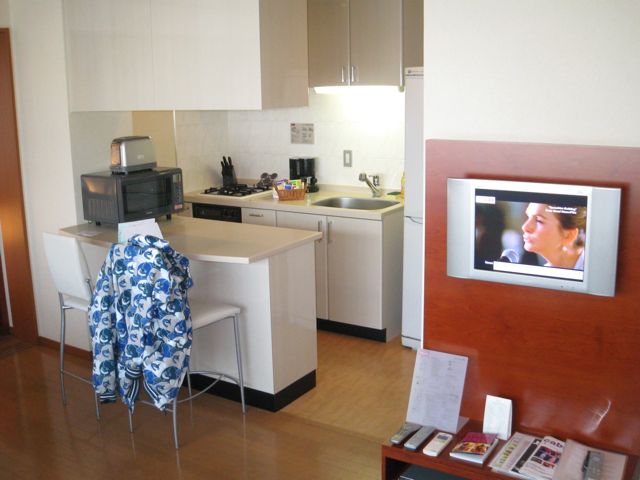
We also had a serviceable little kitchen area to work with. I was getting itchy about not cooking, and this could be the breaking point that would see me buying groceries.
And I had those knives still wrapped up in the scarlet furoshiki……Scud was getting a little nervous about my habit of sleeping with the two boxes by my pillow.

And there was the tub. I love these tubs. I should have taken a shot of the control panel.
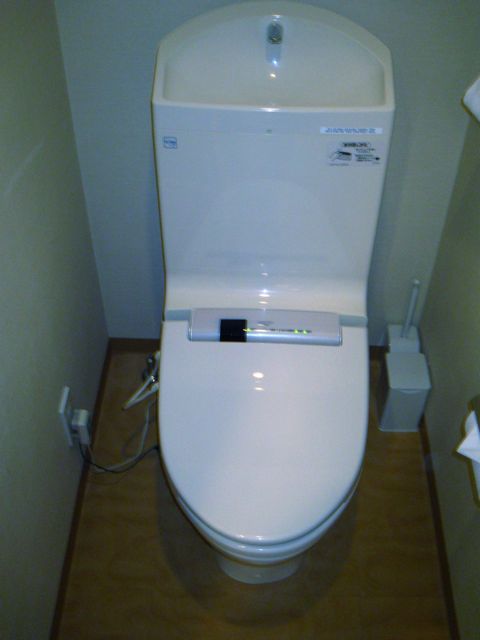
And the facilities were as high tech as one would expect. Again, these came with a daunting collection of flashing lights and buttons.
Shiny…….
I played with the buttons up to the point where Scud finallly yelled at me to stop touching the control panels. One cheerful voice after another was calling for his attention.
“Leave the buttons alone!”
Next: A Late Lunch of Noodles
-
A comment following upon the last post.
I'd thought of writing more on Suntory, it's history and place in modern society, but in looking into the material available, I found a very good blog, Nonjatta , which I'll be spending more of my free time reading through. In addition to well researched articles on Japanese whisky, they've also dug up YouTube links to old Suntory commercials and advertising that is, well, enlightening for me.
For example: " Torys was launched in 1949 with the short and too the point slogan: "It's good, it's cheap.""
Now that's something I can picture Bob Harris saying.

-
March 21 – A Geometrical Aside
Dinner had left the both of us in a good mood, the proper way to finish our time in Kyoto.
Almost.
Scud was keen to return home to the computer, but I wasn’t fully settled yet.
There was a sign we’d been passing near our place. Bar Sherry. It was a small sandwich board, not the sort of thing that really stands out, a wallflower of a sign.
But these are the sort of quiet, passive things that, with time, draw attention, patiently biding, waiting for the moment when you will say “why not?” and look inside.
I was at a “why not?” stage.
I walked up the short flight of stairs, and opened the door.
There was the room, and in the room was the bar.
The bar was of pine, a lighter honey colour. It was three sides of a square, taking up most of the room. Stools faced up upon the bar, with perhaps a clear meter behind the stools to the wall.
The fourth side of the square was the wall. There was a collection of bottles there, but no mirror, just a large rectangle of solid colour (blue, I believe, as I close my eyes).
The lighting was bright enough to write by, but all indirect. No beam of light cast directly upon anything, but was bounced from some surface.
The room that was a bar had one bartender, a younger, 30ish fellow in a black suit, and one couple to the right side of the bar. The three were chatting away in a lively manner, with everyone smiling. The bartender said something as he cleaned a glass, and the customers laughed.
A jazz instrumental was playing. I don’t know enough of jazz to quote the artist. Haruki Murakami could, and as I looked at the room, I was thinking of him.
The bartender looked at me with a friendly, expectant air, and brought me a towel to clean my hands. I smiled back, and looked at their bottles.
Cognacs, sake, shochu, gins, Dutch gins, a good selection of bourbon whiskey, a bottle of Russian Standard vodka, and two bottles of Suntory.
Growing up, we’d always heard about the quality of Japanese whisky, and Suntory was always the standard bearer for the industry. As their historical distillery – Yamazaki – is nearby, between Kyoto and Osaka, this appeared the appropriate time to take a wee dram.
As I said, there were two bottles. One was a 12 year old, the other – Hibiki – was a 17. I asked politely to try the 17.
The bartender’s face fell slightly - a look of presentient sorrow - and he leaned forward. Conspiratorially, I came forward to meet him halfway across the expanse of wood. Quietly, he watned to advise me that it was, perhaps, a little expensive. I nodded my agreement, but indicated that this was not a concern.
His smile returned, and I asked to have the shot straight up,with a glass of water on the side. Perhaps the good Bob Harris wouldn’t take his Suntory in this manner, but nobody is going to mistake me for Bill Murray (he has more hair, for starters).
The Hibiki 17 year old is a blend of Suntory malts. It was cool enough to pick out some individual elements – a bit of pepper, some floweriness – but in general it’s best described as mellow. Not a drink to provoke arguments, perhaps reminding me of a Dalwhinnie more than anything else.
I lingeredover this, and caught up on my notes a little, then relaxed and contemplated the bar itself. It did feel like something from a Haruki Murakami short story. One of those settings without windows, where you may have stepped outside of the bounds of reality for a few lucid moments. The strict confines. The geometrical orderliness, offset by the small hotplate I see behind the counter, and the bundle of receipts in another corner. Form and detail, the proportions being just enough different from my everyday expectations of a bar.
The bartender ensures that my water glass is always three quarters full.
Another couple, two men, enter, give me a curious glance, and then settle down upon my left, trading some pleasantries with the other couple, who have ordered more drinks and continue to chat pleasantly on their side.
I’d be content to write in here, if I had more time. This is a place to collect your thoughts, and perhaps bring some order to things.
I finished my whisky and ask for the cheque. The bartender moved quickly and efficiently, disappearing into a curtained alcove that had only vaguely registered with me. He returned with the paperwork, collected the money from me, and then disappeared again, returning in a moment with my change.
I rose, and the four other patrons nodded pleasantly to me. I nodded in return, smiled, and left.
A room with a bar.
How tidy.
-
Now back to your regular Peter Green programming.
"regular"?

-
Aoki san was kean on pressing more items on me.
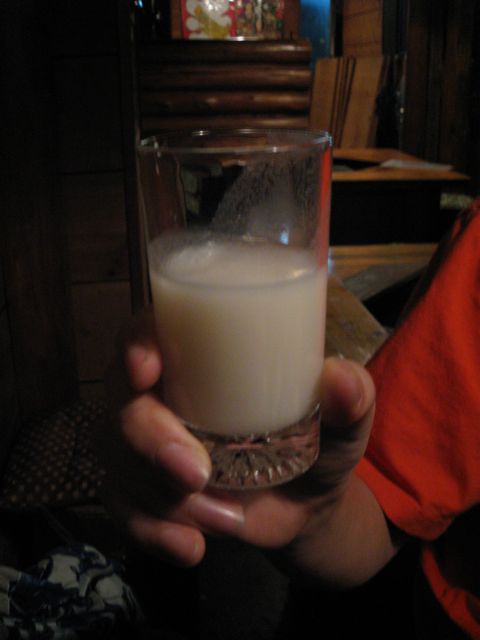
Aoki san shook up a jug, and poured me out a glass of something that looked like an animal-husbandry experiment. This was nigori, home made, unfiltered sake,. A bit on the sweet side, but with the fullness, the ripeness of dongdongju. This was excellent. A good nose, and definitely chewy on the palate. Heck, I’d be tempted to make a sorbet out of this!
Did Mr. Aoki say it was homemade nigori zake? Or, did he say it was doburoku?
I ask this because, in Japan, no individuals are allowed to make any alcoholic beverage with an alcohol content of 1% or greater under the stupid Liquor Tax Law. Provided that the district where the restraunt is located is designated a "doburoku tokku" (tokku = special district), the owner can make doburoku if he applies for permission.
Difference between nigori zake and doburoku:
From here
Doburoku (濁酒) is the classic home-brew style of sake and is traditionally a cloudy milky color, as the most delicious flavors are found in the white residue. Doburoku is created by adding steamed rice at the end of fermentation, starting a second fermentation and raising the alcohol level. It is also unpasteurized. Please note that although the kanji for doburoku and nigorizake are the same and both are opaque, they are in fact different styles of sake, with doburoku being the "chunkier" of the two.In this instance, my notes work. He'd told me it was "nigori; old style sake" that he had made. I hope this doesn't get him in trouble (and if it does, let me know quickly and we'll erase this).
I would say that what I drank wasn't "chunky", not in the same way that dongdongju is. This had a thickness to it, but it was silkier, more like heavy cloud on the tongue than a cup of mucus.
What is the basis for the 1% rule? Is it basically a protection racket for the established producers, going back to the old licensed associations, or is it a more modern food safety regulation (like those (*&^$*s in the FDA who outlaw unpasteurized cheeses from France).
Also, how has this worked with issues like home brewing of beer and wine? Admittedly, I didn't see any home brew shops in Japan like I would have in North America......mind you, I don't see them here in the Middle East, either.....

-
I second that! Let's get the link easier to access! (Hey, you've already got a fair bit of stuff up there).
Okay, I'll stop getting distracted and get more writing up here on my side.
-
I was curious about that restaurant, Okariba, and did some googling. Just as I imagined, the restaurant has close relationships with Shinshu (aka Nagano).
First of all, the interior was decorated to resemble a hut in Shinshu.
Basashi (horsemeat sashimi) comes from Matsumoto, Shinshu.
from here
この猪豚は信州にあるマスターの実家の猪豚牧場から直送されて来るもので、This inobuta (cross between a wild boar and a pig) is sent directly from the inobuta ranch run by the owner's parents.
The owner was once a truck and bus driver.
and from here
熊,いのしし,いのぶた,馬刺,カモ,岩魚,山女魚,アマゴ,きのこ,山菜,信州味噌,野沢菜,蜂の子,イナゴ,さわび,松の実,クルミ,なめたけ,山芋,焼もち,五平もち,朴葉みそ,とうふアゲMany of the items are associated with Shinshu. (Sorry, too busy to translate them into English.)
Thanks very much for that, Hiroyuki!

After watching the way he patiently stood over his grill, I can picture Mr. Aoki perfectly as a bus driver, serene and in control.
It's a good image.
Is Nagano also famous for bugs as food? I'd seen them in Korean diets, but until this meal I'd not connected them with Japan.
Cheers (and thanks!),
Peter
-
There is a one thing I don't understand about Lin Heung teahouse. I see that it was featured in Anthony Bourdain's No Reservation. It was mentioned numerous times on Chow Hound. Now I see Peter and Ron had been there.
Where/what is the attraction?
Yes it seems to be one of the few restaurants in Hong Kong where you can still find dim sum and tea served in a very traditional Cantonese way. You use an open ceremic "dish" to wash your tea cups, chopsticks, and tea is brewed in a bowl with a lid, not in a tea pot. And the steel or aluminium water kettles on the aisle. In addition to sharing a round table with 4 to 5 other parties, (from the No Reservation episode) you probably need to fight with the others to grab your bamboo steamers of har gow, siu mai and char siu bao. When I see the settings in Lin Heung, it reminds of most of the tea houses along Shanghai Street (Jordan) 40 some years ago. That's how Hong Kongers used to "yum cha". (The only difference is they use "dim sum cards" instead of leaving all the bamboo steamers on the table. And hopefully the waitstaff don't sweep all the leftover skins and bones onto a wet ceramic tile floor.) Maybe time has moved on but Lin Heung hasn't. Maybe they chose to run it the traditional way as a means of attraction. I don't know. I haven't been there myself, and probably never will unless I feel like walking through a time tunnel to re-visit my childhood years.
Did you enjoy the Yum Cha experience in Lin Heung?
Yes, I would say I enjoyed it. But, saying that, I would qualify it to say that I enjoyed it in the context of how I was eating for that day.
And for more on that, you'll just have to wait until I finish writing up the Japan trip (otherwise Rona will hunt me down and hurt me).
Next: Goldfinch and a Porkchop

-
Thanks, Hrtz! Whatever it was (and I'll have to dig for this) it was nice and crunchy, and a real pain to eat the thing with chopsticks.
Basically, the dish was an exercise in deconstruction.
But it did taste good.
-
Neko matagi
ねこまたぎ
猫跨ぎ
From here
・猫跨ぎ(ねこまたぎ) 1.不味(まず)い魚。また、捨てるほど大量に捕れる魚。2.塩味が非常にきつい塩漬けの魚。 ★以前は「鮪のトロ」を呼んでいたこともある。釣り人の間では「外道(ヒイラギなど)」を呼ぶ。Fish that is so bad that even a cat (neko) would pass over (matagu) it. Thus, neko matagi.
Interestingly, toro (fatty tuna) was called neko matagi until the advent of modern refrigeration technology.
I wonder if that's an offshoot from the famous dumplings of Tianjin "even a dog wouldn't eat them"?
-
Holly summed everything up as well as can be done.
If you've committed to that horrible time in a flying tube, then you want to optimize your time outside of the airborne cocoon as best you can.
And that means, if you're at all sensible, eating well.
I, of course, am a (an?) horrible wastrel.
But I do try to eat well, when I'm not in need of a nap.

-
In one of those odd coincidences that plague our lives, what should I find, after my last post, but that the disk a friend loaned me - part of his collection of Lone Wolf and Cub (Kozure Okami) films - that I just popped in, starts with a scene of a pilgrim praying under the waterfall at Nanzen-ji oku-no-in that I was just writing about?
We can now all join in singing "it's a small world".....
-
I agree fully with these people.
Bacon is an herb, condiment, side, main, and seasoning.
As well as a cosmetic (give me a woman greased up in bacon fat.....)
Have you tried that one yet from the Raw Bar in Calgary, where they do a bacon foam on their cocktail?

-
March 21 – Kyoto By The Book
The afternoon went very much as a typical Kyoto tour. I took the boy out to Keage Station, and from there we set out to do the temples and the Philosopher’s Walk.
This was the northern route through Higashiyama.
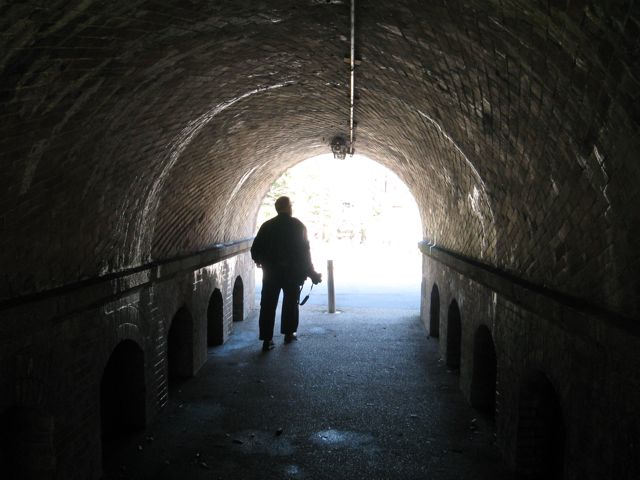
(There’s a photo of me, for those of you who’ve been asking).
We stopped first at the famous gardin of Konchi-In. With all of the urban landscape we’d been taking in these last many days, it seemed like time for a little greenery again.
And, of course, if you’re in Kyoto, you have to do a gravel garden. Given that Scud was relatively shattered from the day’s walking already, this gives one a good excuse to sit down and contemplate the gravel.

Rock on.

From here it was an amiable enough stroll up the hill to Nanzenji, with it’s large edifices.
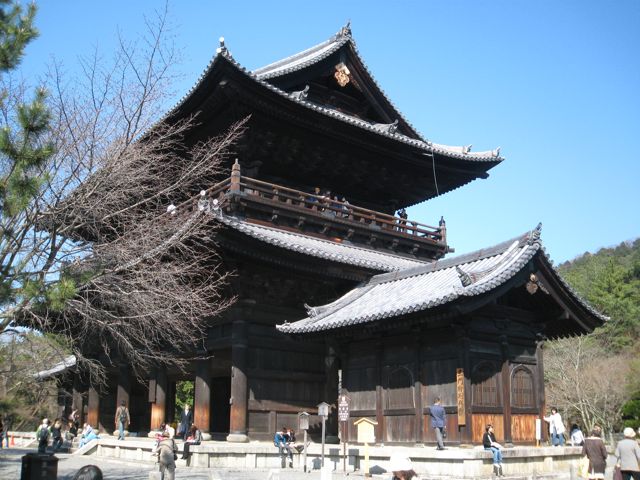
Edifices such as the Sanmon, with beautiful wood pillars.
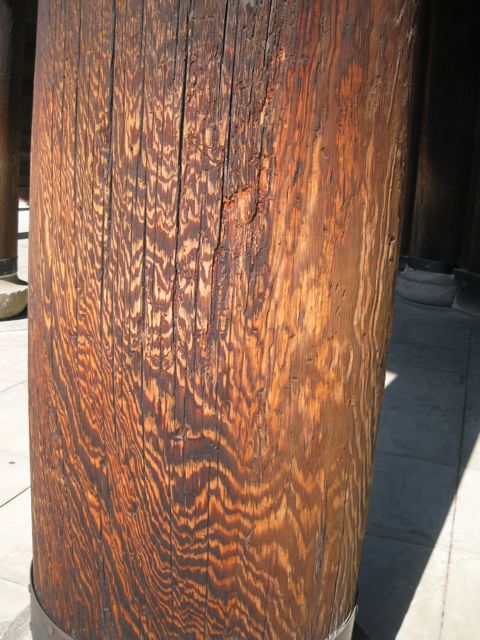
I’ve a thing for wood. Coming from B.C., it’s in-grained in me (sorry!).
I was more interested, though, in getting back up behind Nanzenji to the small shrine at the waterfall I’d read about – Nanzenji-oku-no-in. The path to this took us up a trail back behind the temple, through woods spotted with small shrines.
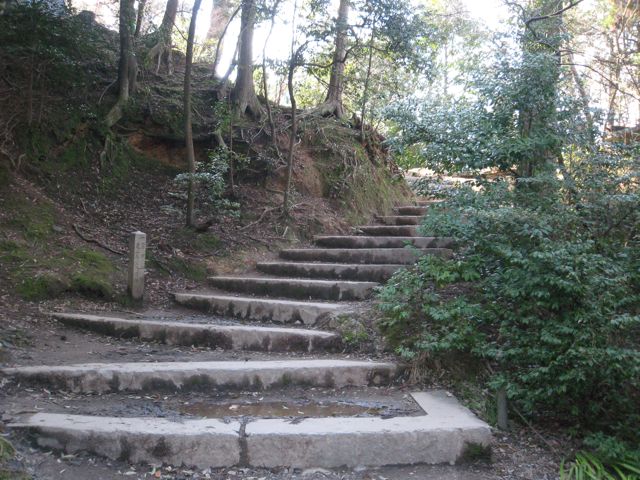
Unfortunately, Scud did not share my interest in this uphill climb, and this was probably the turning point in his tolerance for my walking tour. Descending from the shrine (which at least I thought was very pretty, we made an agreement to drop further temples, other than those that we had to walk through as a matter of course.
Still, I wanted to do the Philosopher’s Walk along the canal. This took us in viewing distance of a number of shrines and temples, and gave us the chance to take in the small shops and cafes up here.

Still, Scud’s mood wasn’t improving, and so, when we came up to the great tourist trap of Ginkkuji we pulled the plug on our day’s touring and headed for home.
I needed to rest him up for dinner.
Okariba
Things didn’t start well.
We’d returned to Keage Station, and I felt pretty good about the directions in hand. Then, outside of the station, I was momentarily nonplussed trying to orient myself properly.
I should point out that the Japanese, when they find a foreigner who appears confused (and I always appear confused) are wonderful about helping out. They’ll drop what they’re doing, and help point you in the right direction.
The only thing was, while the way I had planned to take may not have been the fastest, it was relatively foolproof (even against me).
But what do you do? When someone is kind enough to help me, I feel obliged to accept. And I couldn’t very well hide out somewhere until he’d gone away, and then backtrack? Could I?
What would my son think?
“I think you’re a senile old fool, and I’m putting you in a home first chance!”
Okay, point taken.
Nope, being Canadian I smiled and went with the flow.
So, there we are. Alone, in the middle of the dark of a Higashiyama night, and reliant upon my well honed directional instinct.
Scud was not pleased.
For once, I didn’t care. I had a mission.
The mission was: Okariba, up past the Heian Shrine, near the Okazaki Jinja shrine.
I’d read about this on www.bento.com, recommended by Rona, and a good working reference (except there’s no English version of the maps). They had me at “wild boar”. After listening to Yoonhi drool over boar in Northern Italy, I had to do this.
Scud had to do it to.
Whether he wanted to or not.
Where were we? “Lost, perhaps? In the middle of a dark, semi-forested strip? With no sidewalk and busses flashing past us as we walk on the shoulder?”, says the Boy.
You see, that’s his error. I’m never lost. I’m right where I am. The rest of the universe is just having problems readjusting its coordinate system about me.
I found it, just as I’d expected to find it. Needess to say, I crowed mercilessly over the boy. Doubt me, will he?
“I’m still putting you in a home!”
Okariba is attached, kind of, to the Residence Okazaki, a largish apartment buidling. I say “kind of” as it strikes you more as a wooden hut on the side.
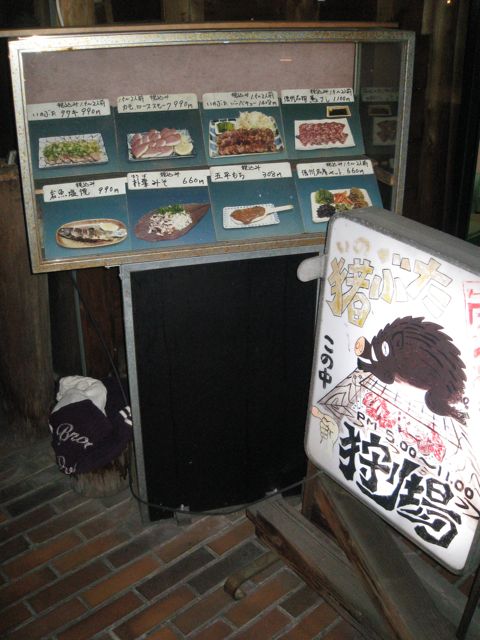
Which makes sense, as the “theme” (although I hesitate to qualify it as such) of this izakaya is that of a small hunting lodge. The owner, Aoki san, hunts a lot of his own food, and brings it back here to cook for his clientelle.
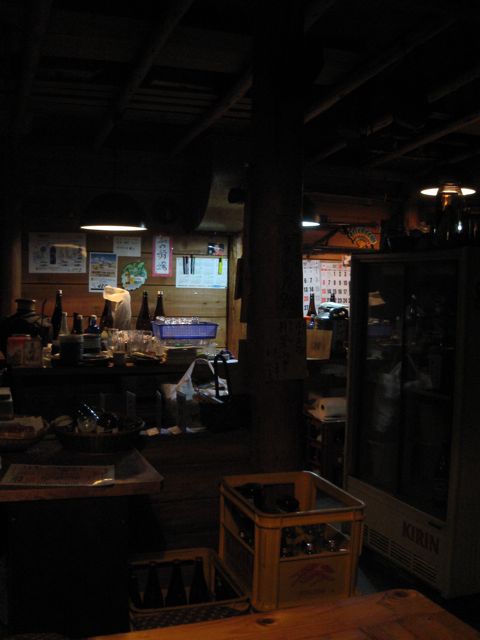
Inside, and I’m in heaven! Solid wood everywhere, rifles hanging on the walls, and bottles, bottles, and bottles. The place has that cheerful clutter that just warms my heart.
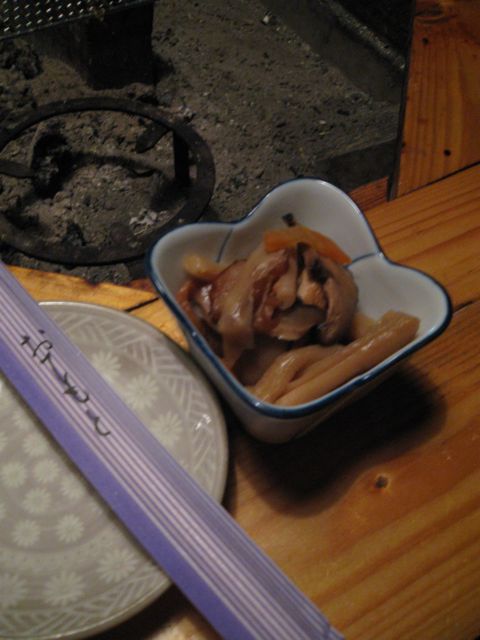
Before we could order (or look at the menu) a wonderful dish of pickled mountain mushrooms was presented to us. Crisp, clean vinegard snapping up the natural goodness of mushrooms. At this point, I knew that our chef, Mr. Aoki, was going to be worth the journey.
Aoki san is kind enough to go through the menu with me. He’s travelled a fair bit, and has enough English to walk me through the menu.
And what a menu it is!
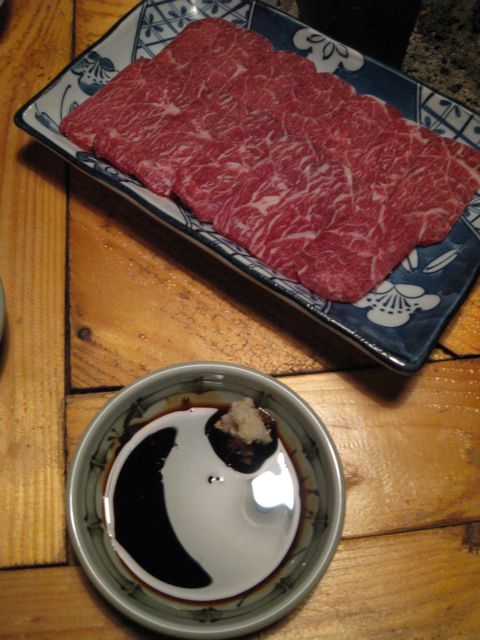
First up is a sashimi of horse. This is freezer-crisp, chillingly cold on the teeth, like meat flavoured ice cream. Just look at the marbling on that. The flavour is rich, and satisfyingly like eating butter. A dab of ginger and dark soy, and this settles me into a mode of general compliance.
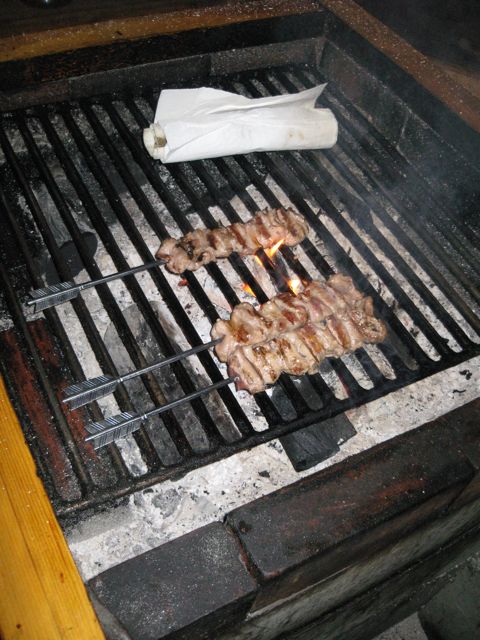
The house specialty is wild boar, which is grilled over charcoal.
I must say, I liked Mr. Aoki from the start. He reminds me, with his cheerful face and ready smile, of my old friend’s family. And, as he cookes, he stands stoically over the grill, turning the meat when it’s necessary, and then returning to a ready position.
Hey, and check out the arrow-skewers! I want some of those!

While the boar grilled, having demolished Mr. Ed’s remains, we turned to a smoked goose. Fine red meat with a wonderful rind of fat and crispy golden skin. As in Shanghai, there’s something in the taste of smoked goose that reminds me of a good ham.
And I love a good ham.
You didn’t expect me to be impartial about this meal, did you?
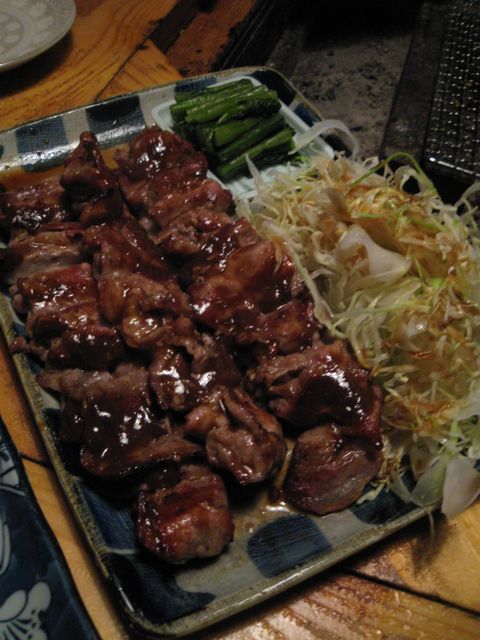
The boar showed up in good time, and it was worth the wait. Moist, fatty, well slathered with a sweet sauce….what’s not to like about this? I’ve had boar in other places in Asia, and you can floss your teeth with the hair and gristle on the measly bits of meat, but this was a fine pig, making me think of the gargantuan proportions of a boar on the Princess Mononoke level.
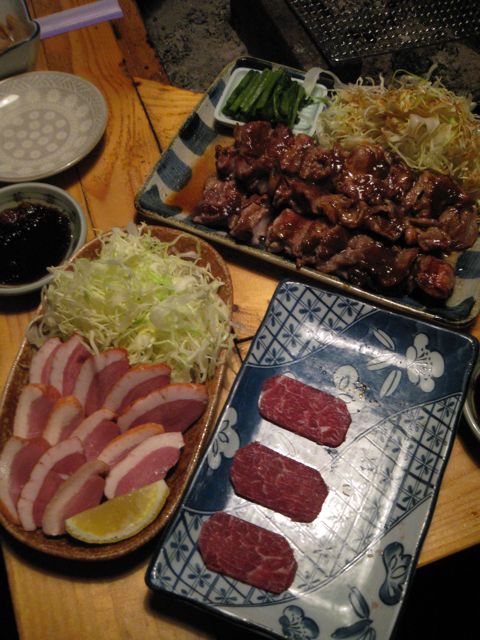
Looking at the picture, I can remember salivating as soon as the smell came up to my nose from the table.
I’m salivating again now.

Afte this I had to try the mushrooms. These were good, and beautifully done, slit open in stars to allow the aroma out, but it was the miso - thick and salty and smooth – that really took my attention. As much as I love mushrooms, they were only a delivery system for the miso.

And now for something completely different. Crickets and bees.
I’ve had crickets before. Laos, and even Houston have these on the menu. But bees?
That’s different.
I’d wanted to order a full dish of both, but Aoki san insisted that I take a free sampler first to see if I liked them.
The crickets were really good, and I made this known in a vocal manner. This is actually what got Aoki san and I talking. The texture, the crisp on these, was just like in Laos, when I’d had these in Vientiane a couple of years ago. He immediately perked up (not that he was lagging in the slightest before), and agreed, so I take it that he’s done at least Thailand at some point.
These were nuty, and the legs were still there. If you read my bit on crickets, grasshoppers, locusts, whatever, in Houston, I wasn’t as thrilled there, as they’d basically husked them, and the resultant texture was more caramelized, giving you the feeling of eating shards of glass……mind you, it was still pretty good. Maybe I should try caramelizing some glass shards?.........
The bees were a mixed bag. On the one hand, it’s something I haven’t eaten before, which always gets big plusses with me. But, on the other hand, they were rather limp, bordering on the wet side. As a bar snack, I prefer things to be crispy.
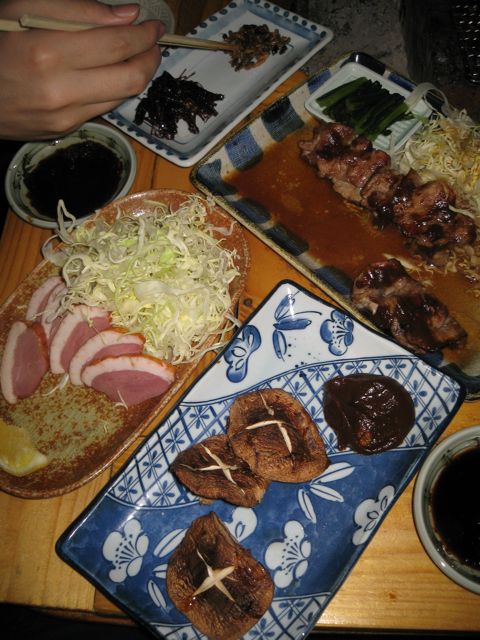
Still, I had no complaints, and these went well with the sake I was drinking (the brand of which I’d forgotten to write down).
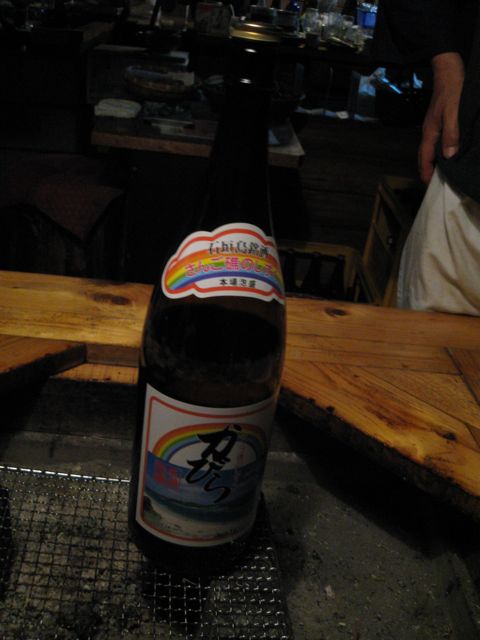
Bugs and dead animal flesh called for something more robust. I asked about rice shochu, and he recommeded this, an Okinawan shochu – kabira.
Ah, nothing like spirits with meat. This worked well with the goose, the flavour of which was definitely changing as it came over from the crispy-cool side of things. Now you could taste more of the smoke, and the overly-fatty meat was, well…..I like it. It’s an interesting comparison of textures on the goose, with the wad of fat greasing your mouth over.
That’s why you need shochu.
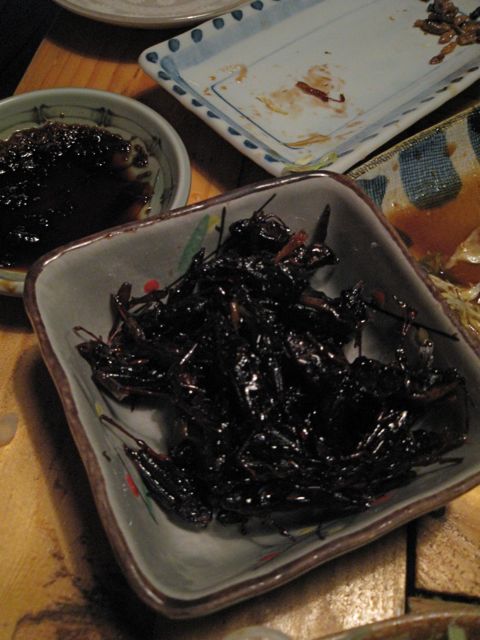
This called for more crickets, and I ordered up a full complement. Aoki san was becomign happier by the minute.
As was I.
(heck, I even saw Scud smile, but he dropped it when I tried to point a camera at him)
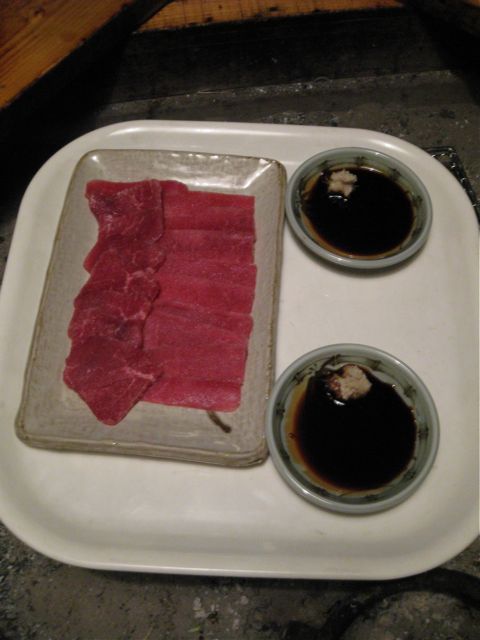
I was interested in the venison sashimi. Our host did check with us, advising that it was raw game, but we assured him that we trusted his judgement.
Plus, I let Scud eat some first.
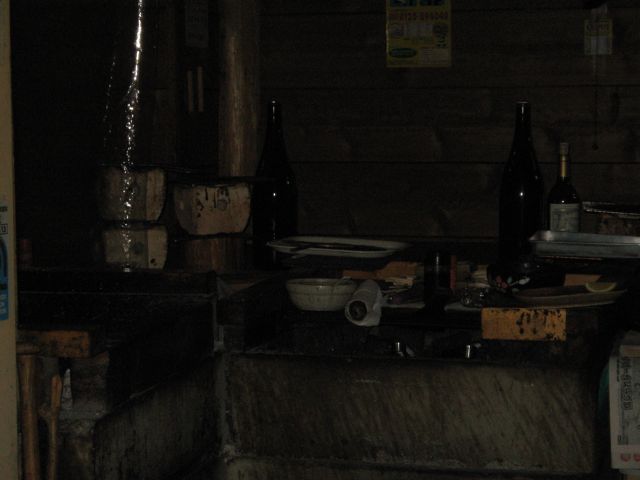
This wasn’t as buttery (as you can see) as the horse, much leaner. The feel in the mouth was much “pullier” the meat holding together tenaciously. But, as you’d expect from lean meat chilled down like this, it was very clean on the palate, and a good match to the shochu.
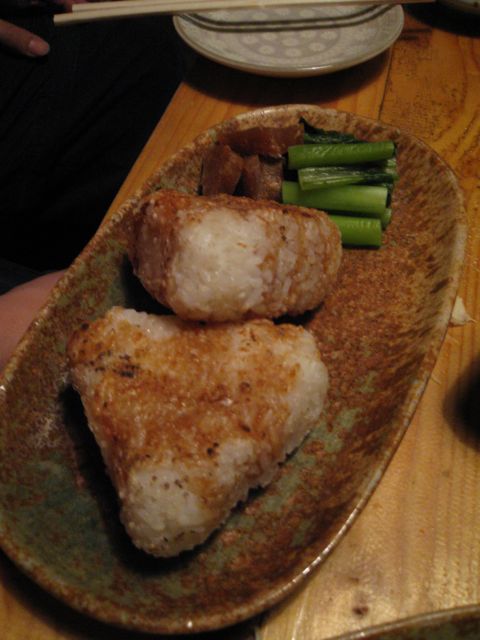
A Japanese meal must include rice, and so our chef grilled a couple of onigiri for us, well crusted with soy, and accompanied with pickles and greens.
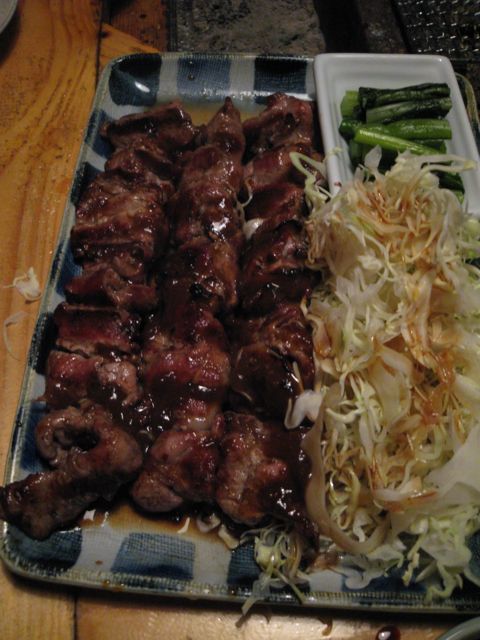
We ordered more boar. It had occurred to us that, when we left here, we weren’t going to see this again for a long time.

At this point, the boy and I were both feeling pretty good about life. This was like being back in Canada, with our Korean relatives having brought back a fresh truckload of game. Call it a guy thing, but this was shaping up to be our best meal so far.
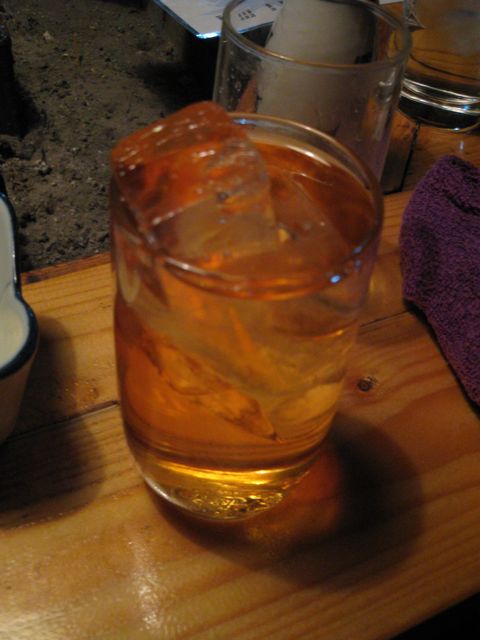
Along with the hunting and cooking always goes drinking, and Aoki san had a number of specialty items. I’d wanted to concentrate on sake and shochu, but, with our eating coming to a slow and pleasurable end, I wanted to try his stuff in jars.
On the menu, he’d had his own plum wine. This had been down in the bottle for two years, and was even and sweet. With ice, it made a nice finish.
But we weren’t finished.
Aoki san was kean on pressing more items on me. And I was kean on accepting.

Aoki san shook up a jug, and poured me out a glass of something that looked like an animal-husbandry experiment. This was nigori, home made, unfiltered sake,. A bit on the sweet side, but with the fullness, the ripeness of dongdongju. This was excellent. A good nose, and definitely chewy on the palate. Heck, I’d be tempted to make a sorbet out of this!
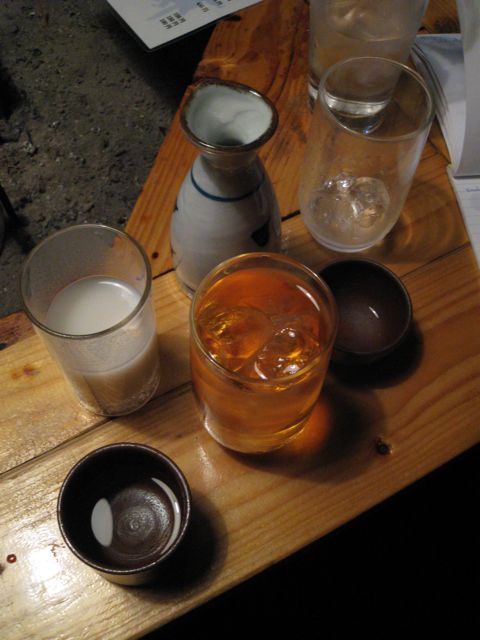
I was becoming quite content in this venue. With every approval I gave, Aoki san would run off to get something else to try out on me.
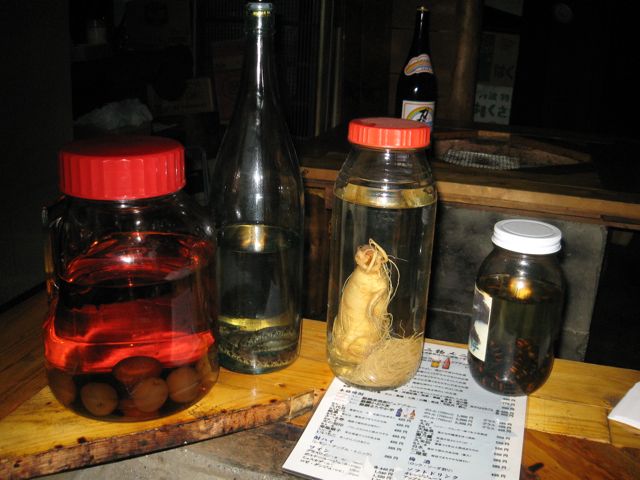
At this point, the stops came out. We’d admired the plums in the spirits, but the he brought out a jar of Korean ginseng soaking in shochu (that brought back memories of Soreoksan) and a bottle with a snake in it (that brings back other memories of China).
And then there was that little jar on the right.

I don’t know why, but for some reason I’d never thought of putting down a bunch of South American killer bees in alcohol.
This is what I call a good evening.

Don’t worry, I didn’t leave anything behind.
Honestly, this was the most memorable meal to date. Perhaps it’s the Korean in me, but a meal of grilled meat, with a good assortment of liquor to go with it, is a hard thing to beat.
Add to that a host overflowing with joy in what he does, and how can you go wrong?
Note: edited to add the close up of the Killer Bees. John Belushi's ghost would've pestered me for eternity if I'd left that off.
And that’s a good point to stop at, for tonight.
Next: Cocktails
-
I haven't given you guys enough food.
Sorry.
Let's do something about that.
-
Ah, he had a good run.
It was interesting, reviewing Kohan Kawauchi's work, that another of his characters, Rainbowman, made a comeback in the Megaman Battle Network series as Shiningman, theme music and all.
The tokusatsu are something I'm going to have to get more into with Tokyo, although we've seen a few of their ilk (more Kaijin - "mysterious people"- representatives) tied in with some of the restaurant photos.
Maybe that would have worked! If Cui-daore had developed a tokusatsu series around the Giant Mecha-Clown fighting to defend Osaka from hordes of evil Health Inspector Puddies intent on closing all the restaurants? Could that have built a fan-base to allow them to weather this storm?
Maybe I should get more sleep?
-
FYI--Cui-daore, the place in Namba where we lunched, is closing. According to the paper, the reasons for closure include "the decrepit state of the facilities, changes in the business environment, and the difficulties of managing the family-run restaurant."
I didn't think it was that bad!
Maybe if they had put that clown inside the restaurant and forced people to eat there in order to have their pictures taken, they wouldn't have had to close.
I didn't see anything decrepit about the place!
......maybe somebody complained about me being in there?

-
Just a thought......
Kyoto is quite close to Osaka in terms of transport, so it is possible to stay in one and see the other to some extent, without the hassle of changing lodgings (which may or may not cost money, but will definitely cost time).
Osaka is also quite a bit less expensive than Tokyo (it felt that way to me) so you may save enough in day to day to offset the extra cost in lodging.
Plus, Osaka is fun.
Just a thought.



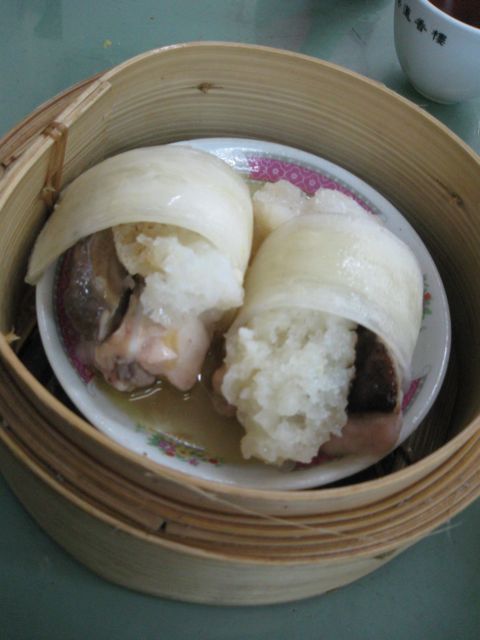
Travelogue: Spirited Away
in Japan: Dining
Posted
March 22 – Roppongi Nights
With a late start to things, the Boy and I found ourselves at loose ends. We’d lunched late, or supped early. We were tired of trains for the day, and still overcome with the comfort of free space to move around in.
We considered the matter. Here we were in the heart of the modern world. A city of culture, mystery, and the arcane (we’d been watching Witch Hunter Robin).
What were we to do?
We went to shoot some pool.
The hall was just across the street from Tsurutontan, upstairs and accessed by an elevator. Easy enough. Inside it was quite chic. Like everything else we’d seen, this place was clean, well stocked with good quality cues and fairly new balls, and tables with nary a tear or scratched.
We were rather disappointed.
We kind of preferred the place in Guilin from last year.
We also preferred the cost in Guilin, which, as far as we could figure out, was pretty much free. You just paid for beer at a few cents a can.
Here you were paying 1000 yen a half hour for pool or darts, and they did ask you to “please buy one drink per person”. Luckily, I didn’t notice the one drink per person rule until we were leaving, and they were too polite to say anything.
Yeah, I’m just cheap.
Scud and I returned to the Precce in Midtown, and did a little grocery shopping, hoping this would raise our appetite for more eating. Likewise, the kitchen had seemed just too bare for the likes of us. A refridgerator, in particular, is far too sad when it’s empty.
Some cheese and a 6 pack make a world of difference.
We’d also found some mochi. Two different kinds…… I better check. Are these mochi? They tasted soft and ricey and sweet, but I’ve been wrong before. There’s part of the kanji for mochi there, atop “nagara no idawari”. (Does someone care to sneak in here for quick bit of help?)
For arguments sake, we’ll say they’re mochi. This presented a problem. I was interested in heading out again, but leaving this behind with the boy meant that I would probably not be seeing them when I got back.
So we ate them.
We also devastated the package of dried stuff we’d bought. I bought it thinking it was shredded squid, but I don’t think that was it……
And then it just seemed appropriate to eat the cheese with some of the stoned wheat thins that I’d had Scud cart from Canada (can’t beat a stoned wheat thin as a companion for cheese).
Okay, so by this point in time we’d worked our way to a point where we needed to go buy more groceries.
Unfortunately, we’d taken the edge off of our appetites.
And it was dark.
We did a tour of the district, admiring some of the sites. Most impressive, especially for Scud, was Tokyo Tower, icon of many a Godzilla movie. Lit up at night, it did make for a wonderful backdrop. Fill in the middle distance with neon lights and crowded buildings, and this city boy is perking right up.
The foreground was another matter.
The street corners appear to be home to a large percentage of the population of the Bight of Benin. And every one of them wants to be my best friend, very concerned about my well being and what I may be looking for tonight. Because they “had just the place for me”.
Without exception, they were all African. There were Asians, but they were only hitting on the other Asians. Likewise, the Africans didn’t bother the Japanese males (females were another matter). A division of labour, similar to the Portugese and the Spanish dividing the world’s hostess bars amongst them.
Scud lucked out. He either looked too Asian or too young for the guys bothering me, or he looked to Western for the Japanese. In either case, he just walked behind me and smirked as I would try to shake off whatever had attached to me.
Someday I’ll get even.
But let’s not dwell on the negative.
On the lighter side, Roppongi was looking like a good place for a beer. Heck, in a Homer Simpson moment we even had the Dancing Corona make an appearance.
There were a number of Belgian specialists just around the crossing. There was the Abbot’s choice near Almond (the patisserie). Then there was the enticing Cavern, advertising “world beer”.
And further back up Roppongi there was Belg Aube.
Decisions, decisions.
Really, I was hoping that this walkabout would wake our appetite up for more food. Scud was sort of interested in trying the yakitori place across from Midtown, as it should be open by this time, but there was a scrum of touts firmly in place working for the strip bars that were clustered in the same building, so that sort of put him off.
There was this interesting place, advertising “Trick or Treat Horror Dining”. I know, I’ll go to my grave wishing I’d gone in here.
We considered more udon, but now there was a long line stretching out of the doors of Tsurutontan. We wouldn’t be eating there right now (but it’s good to know it’s popular).
So, I settled on Hobgoblin. Down the street, away from the worst of the action and sporting a friendly faux-Anglo façade. It’s a name I recognize. I stopped in for a beer, and Scud hauled the new groceries back home.
It’s good to be the boss.
Not a bad pub. Large, lots of wood, and darts that don’t cost you $20 an hour to play on. This is their second pub, the original being back down the hill in Akasaka, dating back to 2000. They’ve got another in Shibuya, and opened a place in Kobe recently.
I shouldn’t be too hasty about the faux-Anglo thing. They are associated with the Wychwood Brewery in England, who’re one of the small breweries that arose in the 1980’s from the carnage of the large brewery buy-outs. For a time there it seemed that the big boys were buying out anyone with a sense of taste, crushing individuality in the beer business. But, as always happens, there’s always some bright young lads ready to step in with a good pint. Wychwood has an impressive array of awards for their beers, with Hobgoblin Ale being a stand-out, and the impressively titled Dog’s Bollocks.
How could you not love Dog’s Bollocks?
I ordered their house Hobgoblin Ale (there goes that 1000 yen note after all). This came with a a dark woody colour and a crisp head that collapsed failry soon. The ale was well hopped, and a nice change for me. I thrive on variety.
I used the time to catch up on my notes, and tried to plan what was still left of our time.
Planning has not been our strong suite this trip.
One thing that was hurting me was that I hadn’t been able to find a Michelin Guide yet. There’s an English language bookstore just over towards Roppongi Hills, and I’d hit it up as soon as I saw it (Aoyama Books, I think?), but they were sold out of the Guide.
This was an impediment.
There’s a lot of controversy over Michellin covering Tokyo, but I’ll discuss that later as we go along. For now, I’d intended to rely upon it for mapping out my future eats. I did have a copy of the list on board my computer, so that would have to do.
Somewhere along the way, the ale had disappeared from my pint glass. I wonder how that happens?
I called over a waitress and asked about the “guest ale”. This turned out to be an IPA by Green King. Now, given my stated belief in the need to go with a coincidence when one finds you, and the fact that I’m partially to IPA’s……well, there’s goes another 1000 yen note.
I always wonder, when seeing a bar shirt that says “staff” is it a statement of employment, or a proclamation of disease?
What appeared was a very nice IPA with good hops, and a milk-maid creamy head. This I could linger over quite readily.
The bar became louder as time progressed, and I found my notes in order, at least for the moment. If I took the side streets to the cemetery I could probably avoid my new “friends” on the main drag.
Some cheese and crackers would be good right now……….If the Boy’s left me any…….